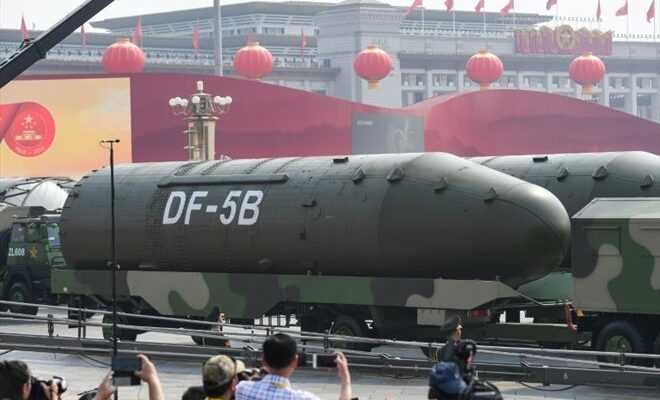Chinese warships cross the Torres Strait between Australia and Papua New Guinea on February 18, 2022 (Australian Defense Force/AFP/Archives/Handout)
China announced on Saturday a boost to its military spending, in a context of global tension revived by the Russian invasion of Ukraine and its traditional rivalry with Taiwan and those bordering the South China Sea.
The military budget will increase by 7.1% this year, announced the Ministry of Finance at the opening of the annual plenary session of the National People’s Congress (NPC, the Chinese Parliament).
This percentage is up on last year (+6.8%). This is the strongest increase since 2019 (+7.5%).
With this envelope of 1.450 billion yuan (230 billion dollars), China has the second largest defense budget in the world, after the United States (740 billion USD planned for 2022).
Above all, the increase in Chinese military spending is significantly higher than expected GDP growth, set on Saturday by Prime Minister Li Keqiang at 5.5% for the current year.
The increase comes as global tensions escalated last week over Russia’s intervention in Ukraine, which Beijing has so far declined to condemn, saying it “understands” Moscow’s security concerns.
During a visit by Russian President Vladimir Putin to Beijing in early February, the two countries spoke out against NATO expansion.
Chinese President Xi Jinping for his part obtained the support of his neighbor to denounce the “negative influence for peace and stability” of the United States in the Asia-Pacific region.

A military propaganda poster in Beijing in May 2021 (AFP/Archives/NOEL CELIS)
Beijing continues to raise its voice to attack the rival regime in Taiwan, the island which it considers to be one of its provinces and which it reserves the right to seize by force.
Last year, the communist regime stepped up incursions into Taiwan’s air defense identification zone, particularly in response to visits by senior US officials to the island.
Last month, Xi Jinping ordered all military units to conduct “combat-oriented drills” and improve their “combat-combat” capabilities.
– Hypersonic glider –
The reinforcement of the Chinese army arouses recurring mistrust from neighboring nations, fueled by a lack of transparency on what exactly the military budget covers.

DF-5B intercontinental ballistic missiles during a military parade in Beijing on October 1, 2019 (AFP/Archives/GREG BAKER)
China thus claims its sovereignty in the South China Sea (vis-à-vis Vietnam and the Philippines in particular), in the East China Sea (on the Senkaku Islands controlled by Japan) as well as in the Himalayas (facing the ‘India).
The United States regularly sends warships to the South China Sea to thwart Beijing’s territorial claims there, but also close to Taiwan to support local leaders there.
In this context, the Beijing army continues its modernization with the aim of catching up with Washington’s technological advance.
According to the Pentagon, the People’s Liberation Army (PLA) notably launched a hypersonic glider last year, which circled the Earth at more than 6,000 km / h.
The device would have fired a projectile during its run, a performance that seems to have taken the Americans by surprise, Washington not yet having this type of armament.
“The PLA is the strong arm of the Communist Party of China and the party leadership needs the continued support of the military,” said James Char, a defense expert at Nanyang Technological University in Singapore.
“One of the ways to achieve this is to prove that the needs of the PLA remain a priority,” he adds.
For its part, the Chinese army gives priority to the modernization of its equipment “in order to become a fully mechanized and computerized force”.
© 2022 AFP
Did you like this article ? Share it with your friends with the buttons below.




